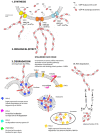Hyaluronic Acid: Known for Almost a Century, but Still in Vogue
- PMID: 35456670
- PMCID: PMC9029726
- DOI: 10.3390/pharmaceutics14040838
Hyaluronic Acid: Known for Almost a Century, but Still in Vogue
Abstract
Hyaluronic acid (HA) has a special position among glycosaminoglycans. As a major component of the extracellular matrix (ECM). This simple, unbranched polysaccharide is involved in the regulation of various biological cell processes, whether under physiological conditions or in cases of cell damage. This review summarizes the history of this molecule's study, its distinctive metabolic pathway in the body, its unique properties, and current information regarding its interaction partners. Our main goal, however, is to intensively investigate whether this relatively simple polymer may find applications in protecting against ionizing radiation (IR) or for therapy in cases of radiation-induced damage. After exposure to IR, acute and belated damage develops in each tissue depending upon the dose received and the cellular composition of a given organ. A common feature of all organ damage is a distinct change in composition and structure of the ECM. In particular, the important role of HA was shown in lung tissue and the variability of this flexible molecule in the complex mechanism of radiation-induced lung injuries. Moreover, HA is also involved in intermediating cell behavior during morphogenesis and in tissue repair during inflammation, injury, and would healing. The possibility of using the HA polymer to affect or treat radiation tissue damage may point to the missing gaps in the responsible mechanisms in the onset of this disease. Therefore, in this article, we will also focus on obtaining answers from current knowledge and the results of studies as to whether hyaluronic acid can also find application in radiation science.
Keywords: hyaluronan receptor; hyaluronic acid; radiation; radioprotection; therapeutic application.
Conflict of interest statement
The authors declare no conflict of interest.
Figures




References
Publication types
Grants and funding
LinkOut - more resources
Full Text Sources
Research Materials

